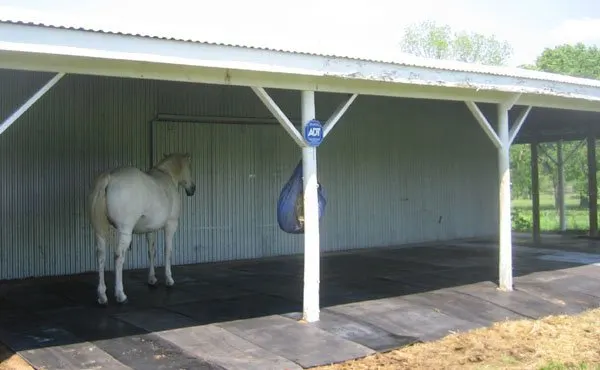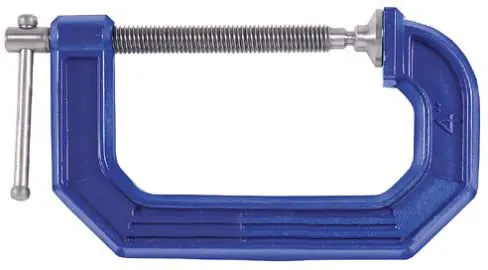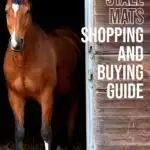Horse stall mats are a great way to upgrade your barn or stable. Good stall mats can last for years, improve joint health and comfort for horses, and reduce both cost and time spent cleaning stalls. Horse stall mats, usually made from reinforced rubber, can be purchased in a number of different styles, thicknesses, and textures. Most mats are flat and solid (similar to spongey gym flooring, but denser to support heavy horse bodies) but a few brands are available that offer extra cushioning.
Stall mats don’t replace typical bedding (which is typically, pine wood shavings or straw) but instead, these mats provide a bit of a soft surface to underlie bedding. These mats can help make horses more comfortable and minimize the need for extra bedding. Instead of spending money on loading a stall with extra bedding to provide some cushioning for horses, good stall mats mean you can stop wasting bedding on comfort and only use enough to absorb waste.
Although horse mats can be an expensive initial investment, many horse owners find that over time, the savings earned from buying less betting betting stall bedding can cover the cost of the initial investment.

Fitting stall mats into your horse’s stall
Most mats designed and sold for horse stalls available through agriculture supply stores and equestrian supply catalogs measure 4 feet x 8 feet. These should fit even custom horse stall sizes such as those created when building your own DIY cheap horse stalls. Even though the standard horse stall is 12ft by 12 foot, the smaller 4×8 size makes them easier to move (more on that later) and custom fit to non-standard size horse stalls. If you don’t have standard-sized horse stalls, you may need to have custom-shaped mats cut or cut your own during the installation process.
How to know if stall mats are right for your horse
To determine if stall mats are a good idea for your horse in your barn, it’s a good idea to run the idea past your veterinarian before purchasing. Not all mats designed for stalls are created equal, and while rubber mats in stalls are generally believed to improve comfort and joint health, there is some evidence that rubber mats (particularly in horse trailers) may amplify impact – potentially leading to more joint pain for some older or arthritic horses.
Before purchase, you’ll also want to inquire with the manufacturer what their stall mats are manufactured from, as some formulations of rubber can give off noxious fumes – just imagine trying to sleep on top of a mattress of stinky rubber!
Cheaper alternatives to stall mats
When our farm was located in Southwest Missouri – an area where mineral mining is still very much an active industry- conveyor belt mats from the mining industry were often resold as horse stall mats. These large, heavy, threaded rubber mats were a fraction of the cost of horse stall mats sold through farm stores and online sellers, but provided the same cushioning. To keep mines operating without interruption, the wide conveyer-belt rubber mats were removed and replaced regularly- even if they showed no signs of wear. If you’re open to alternative mats such as these, you may be able to save on your barn’s installation.

Often, the most expensive part of purchasing rubber mats for stalls is the shipping cost to get them to your location. To save money on your installation of stall mats, look for a local or regional manufacturer and arrange to pick them up directly using your horse trailer. Eliminating the middle dealer is a great way to save particularly if you need a large number of mats to line multiple stalls in your stable.
How to deal with odors from stall mats
In the long run, using stall mats should reduce odor in your barn by reducing the amount of urine that reaches the subsurface of your stalls. However, in the short-range some horse owners find that the odor given off by brand-new rubber mats for stalls is intolerable.
The best way to get rid of the odor from new stall mats is to allow them to off-gas outdoors for a week or more before installing. To speed this process, you can leave your new mats outdoors in a single layer.
One way to reduce the odor from already-installed rubber mats is to mix activated charcoal with your bedding for a few weeks. Millions of tiny pores on activated charcoal molecules allow it to bind with odor-causing molecules, odors can then be swept away when you clean stalls.
Usually, horse stall mats stop smelling, noticeably, within a few weeks.
How to move horse stall mats
One of the worst parts of having rubber mats in horse stalls is how difficult they are to move when you need to deep clean a stall or rearrange the mats. Some mats on certain surfaces may shift as horses lay down and stand up, requiring regular repositioning.
Moving stall mats is such a tedious task that you can actually purchase devices designed to help you get a grip on the heavy and hard to hold mats. But you don’t need to buy a special tool if you have a basic hardware kit. In most good toolboxes you’ll find a C clamp. C clamps like this 6″ C-clamp pictured here screw down on a thin surface like a stall mat making them easy to move. The big C-shaped arm makes an easy to hold handle allowing you to drag the mat wherever you need it.


